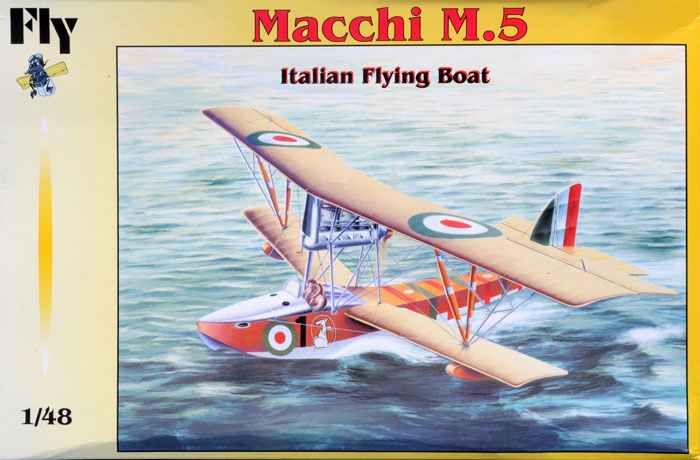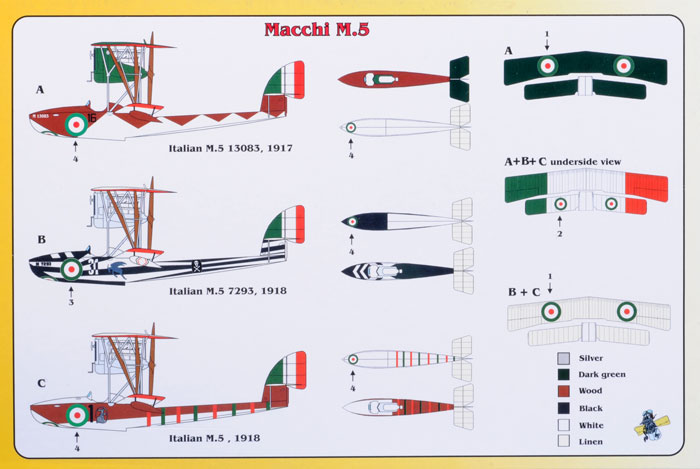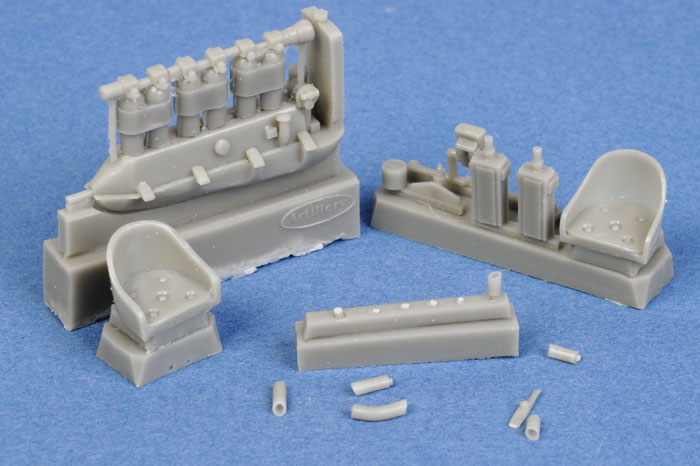|
Macchi M.5
Italian Flying Boat

Fly, 1/48 scale
S
u m m a r y |
| Catalogue Number: |
Fly 480001 - Macchi M.5 |
| Scale: |
1/48 |
| Contents and Media: |
66 parts cast from beige styrene, 1 part cast from clear, 16 parts cast from grey resin (2 not used for this version), decals for three subjects. |
| Price: |
GBP£22.64 available online from Hannants
will be available from Squadron and specialist retailers worldwide |
| Review Type: |
FirstLook |
| Advantages: |
Well engineered kit of a rare subject. Beautifully detailed resin and attract colour scheme options. |
| Disadvantages: |
None; beyond the skill required to make a biplane kit |
| Conclusions: |
Excellent kit of a rare and interesting subject. |
Reviewed by Peter Mitchell

Fly's 1/48 scale Macchi M.5 Flying Boat will be available online from Squadron.com
For modelers of aircraft of the 1914-1918 era, the last ten yeas has been a second “Golden Age” not seen since the late 1960-70’s.
We are now treated to a range and quality of kit never seen before. This has been widespread across the two major scales (1/72 and 1/48) and is now making a welcome intrusion into the larger 1/32.
While the variety of types available has been great, with the release of many exotic and rarely seen breeds now commonplace, we have seen very few floatplanes and virtually no flying-boats.
Thoughts of aerial combat during the Great War of 1914-1918 usually conjures up some sort of hazy images of primitive aircraft dueling in a chaotic melee high above a scared and muddy landscape.
This romatised view of the air war over the Western Front is perhaps as synonymous with the Great War as trench warfare.
However just as different battlefronts did not always involve a static trench warfare, the air-war was not always what most people generally associate with World War One.

The war on the Italian front is good example, since the battlefront ranged from the deep valleys of the Dolomitic Alps in the west to the long coastline of the Italian Peninsula in the east. Along this Adriatic coastline, Austria-Hungary and Italy faced each other across distance of 75-100 miles of water stretching along some 400-500 miles of coastline. Consequently a good deal of the air war in this theatre took place over water.
The difficulty of establishing effective land plane bases to defend this front prompted the development of a range of water borne aircraft by both the Austro-Hungarian and Italian forces.
The Austrians developed the excellent line of Lohner flying boats and these became the inspiration for the Macchi line of flying boats culminating in the M.5.
Using their experience in the license manufacturer of Nieuport scouts, Macchi-Nieuport at Varese combined the Lohner-like designed hull with the sesquiplane wing design of a Nieuport 17.
The Macchi M.5 had single-step hull and an open cockpit forward of the wings, armed with a pair of Vickers guns and powered by a single Isotta-Fraschini V.4B engine in pusher configuration. The resulting design was a fast (117 mph) and manoeuvrable flying boat, capable of taking on land- based planes on virtually equal terms.
Operated by five Italian maritime patrol squadrons, the M.5 was used as a fighter and also for convoy escorts. It is a little known fact that these flying boats were also flown by both United States Navy and United States Marine Corps airmen alongside the Italians and it was while flying a Macchi M.5 that Ensign Charles Hammann won the first Medal of Honor awarded to a United States naval aviator in 1918.
Macchi produced 200 aircraft and another 44 were built by Societa Aeronautica Italiana.
Examples of this flying boat remained in Italian service until the mid 1920s.
Fly's 1/48 scale Macchi M.5 kit features 66 parts cast from beige styrene arranged over two sprues, one part cast from clear styrene and sixteen parts cast from grey resin, decals are provided for three subjects. The parts come packaged in an end opening box featuring some attractive box art on the top while the back is reserved for the painting and decal placement guide.
Inside, the styrene and resin parts are packaged separately in zip-seal bags.
The styrene parts are all beautifully moulded and are largely flash free, the wings are beautifully rendered, they are appropriately thin and the effect of the linen stretched over the wing ribs is most convincing.
The fuselage is assembled from four pieces; a left and right side, rear top deck and lower forward hull. Each lower wing is then attached by locating pins for the fuselage/wing joint.
A quick dry fit reveals that the fit is positive and construction should be quite straight forward; this is a well engineered kit and is reminiscent of some of the second generation kits produced by Eduard; in fact it would not surprise me if Eduard had some hand in this kits design.
The usual care will be required when applying the top wing, the strut assembly is sensibly arranged and with patience this shouldn’t pose too big a headache although the use of a jig will is to be recommended.
The castings of the resin parts are all smooth, free of warpage and there is no evidence of any air bubbles, the casting for the Isotta-Fraschini engine is particularly well done.

The kit has adequate internal detail and anyone wanting to improve on what is provided will have an excellent starting point. The cockpit features a floor, rudder bar and joy-stick. The sidewalls feature separate parts for the Vickers machine gun butts and a throttle. An instrument panel is provided and this also features a barometric altimeter. The upper fuselage skylights will need to be drilled out and filled with a clear medium.
A foldout instruction sheet is provided which features seven construction steps and a rigging diagram. While busy, this is for the most part quite clear, although there is no information as to which of the options utilises some of the alternate parts. Some judicious use of references may be required here.
The decals are well printed, they are in register and have good colour density. Very little carrier film is evident.

Three attractive colour livery options are provided with the decals and it will be hard to choose which one to do.
- Macchi M.5 13083. 261a Squadriglia, 1917. Natural wood and White saw-tooth pattern on the fuselage. Green upper wings.
- Macchi M.5 7293. “32” 1918. Black and White “dazzle” pattern on the fuselage with a winged goat and skull and cross bones insignias. Natural linen upper wings.
- Macchi M.5 “1”. 260 Squadriglia, 1918. Natural wood over White Red and Green band patterned fuselage with winged rat/kangaroo (?) insignia. Natural linen upper wings.
In terms of subject, this kit is pretty rare, perhaps unique in this scale. I suspect that this type has been on many WWI modellers list of “wants”.
Fly has done this unique subject justice and with a little care will make an excellent model of the Macchi M.5.
Thanks to MPM / Fly for this review
sample.
Review Text Copyright © 2008 by Peter Mitchell
Images Copyright © 2008 by Brett Green
Page Created 18 November, 2008
Last updated 18 November, 2008
Back to HyperScale Main Page
Back to Reviews Page |
